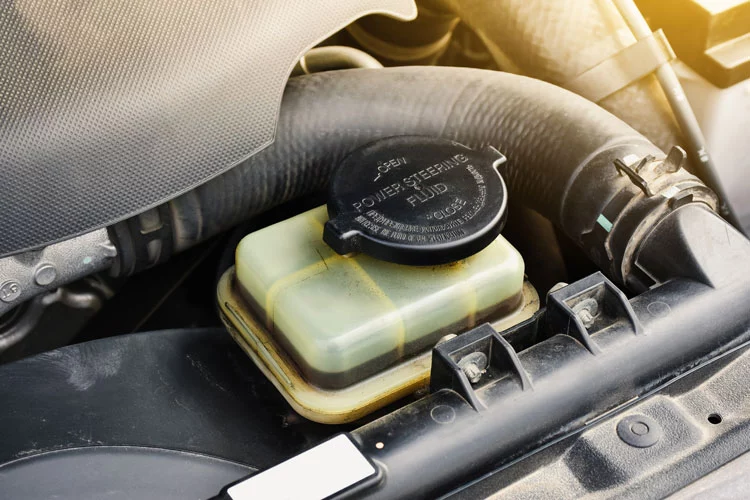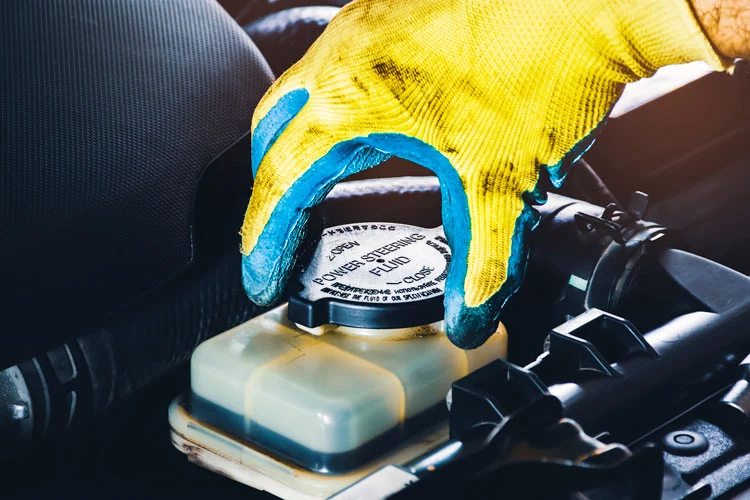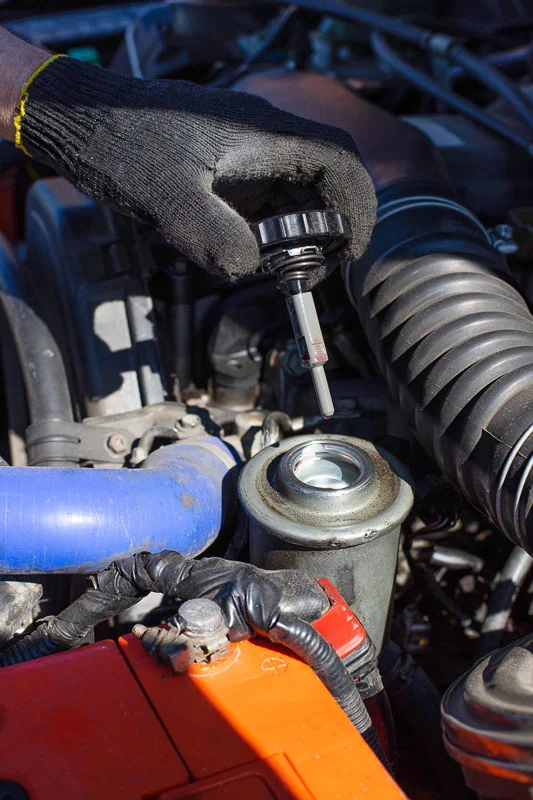Power steering is a standard feature in vehicles today. Unlike the older models, cars with power steering need a lubricant such as power steering fluid for a smooth operation. This is due to the moving parts which create friction during operation. Without lubrication, it can cause premature wear and tear in the internal components.
The car power steering fluid is essential for the performance of your car. It makes turning your car easy and also helps during tricky maneuvers. But, driving without the fluid can ruin the power steering pump leading to friction and heat.
Over time, it can damage your power steering unit, leaving you with expensive repairs. This is why you need to keep track of your fluid levels and do a fluid change as and when needed.
This article has everything you need to know about power steering fluid. Keep reading to know more about how and when to change the fluid, and more.
What is a Power Steering Fluid?
Power steering fluid is nothing but a hydraulic fluid used in the steering system. It helps create a hydraulic link between the front wheel and the steering. As a result, the fluid helps to build and transfer pressure quicker and with much less effort. This reduces the effort required to turn the wheel. Moreover, it also lubricates the moving parts and prevents corrosion.
As a critical component of your car, power steering helps make the driver’s job easier. The fluid provides hydraulic assistance to the system when you turn the wheel. This makes it easy to control your car, especially in tight spots. Without the assistance, turning will require a significant effort from the driver.
What are the Different Types of Power Steering Fluid?
Power steering fluid ensures that the pump, piston, valve, and hose works in an optimal condition. It keeps the power steering system functioning best for easy and smooth rides.
Below are the three common power steering fluids available in the market. Each one of them has different properties and will vary depending on the car.
Automatic Transmission Fluid (ATF)
Some cars accept the transmission fluid used in automatic transmissions for steering systems. In this case, you can use Mercon, Dexron, Type-F, and ATF+4 for your power steering.
Older vehicles made in the 1970s-1990s take ATF transmission fluid for their power steering. This includes Ford, Chrysler, GM, and Volkswagen(built in the US).
Synthetic-Based Hydraulic Fluid
Many vehicles, especially European and Japanese-built, have different standards than in the US. These vehicles require a high-performance synthetic fluid to meet their standards. It flows well even at low temperatures increasing the pump lubrication.
This includes European-built vehicles such as Volvo, Porsche, Volkswagen, Audi, and BMW. The standards also depend on the make and model of the vehicle. The same goes for Japanese brands such as Nissan, Toyota, Mitsubishi, Honda, and Subaru.
Universal Power Steering Fluid
Modern vehicles also accept the universal power steering fluid. But, they require special additives to increase lubrication and corrosion protection.
Note: An incompatible fluid can cause untold damage to the system. So, refer to the owner’s manual for the power steering fluid suitable for your car.
When Should I Change the Power Steering Fluid?
The rule of thumb is to replace the power steering fluid at five years or 50,000 miles, whichever comes first. Power steering fluid is generally present in a clean environment. Hence it lasts much longer than any other automobile fluid. However, most manufacturers do not specify a set period to change the fluid.
After the time mentioned above, the fluid tends to break down. You may even notice contamination which in turn affects the hose and power steering pump. Moreover, the anti-corrosive additives also begin depleting. This, combined with the increased temperatures, can cause the fluid to oxidize. Also, if the fluid appears dark or dirty, change it as soon as possible.
The role of the power steering fluid is to provide lubrication. If it takes debris and water, it’s not as efficient, which may harm the system. In addition, old fluid in the power steering pump can generate noise and fail in the end.
How do You Know if You Need Power Steering Fluid?
Power steering fluid is a must-have for a pleasant and safe drive. However, if you hear any noise or feel a jerk, your fluid may be to blame. The following are some of the warning signs that you’ll need to replace your power steering fluid.
- Power steering fluid is pretty clear with a tinge of amber, red or pink color. If the fluid in your system is black, dark brown, or foamy, you’ll need to replace, as early as possible. It’s likely been contaminated with debris from the connecting hoses, O-rings, or seals.
- Much like any other fluid in your car, the power steering fluid also collects debris and moisture. At this stage, you can hear a whining noise from your pump.
- A shrieking sound during steering signals low power steering fluid levels. This indicates that you may leak somewhere. Since the steering fluid is in a sealed environment, leaks can cause a low fluid level due to leaks.
- If your steering wheel is jerking when you turn left or right, it indicates a low power steering fluid level. Another indication of the low fluid level is difficulty in turning the wheels.
Replacing the power steering fluid is much cheaper than having to change the pump. Visit your auto mechanic and determine the best plan to change the power steering fluid in your car.
How Long Can You Drive with Low Power Steering Fluid?
It is not safe to drive your car with low-power steering fluid. However, nothing stops you from driving in the meantime.
Power steering fluid is used in the steering unit to lubricate and dissipate heat. Without it, the pump will seize, which will cause the belt to fail. Over time, your overheated engine will stop working, and so will the battery.
In other words, it is safer not to drive your car with low fluid levels. And if you have to drive, ensure that it is to an auto repair shop to change the power steering fluid.
Is it Bad to Drive with Low-Power Steering Fluid?
Yes! It is not safe and a terrible idea to drive with a low fluid level.
Driving your vehicle for an extended period without the steering fluid can be bad for your car. First and foremost, your driving quality will be affected. Second, while your steering still works, you will find it laborious to turn. Forget about parallel parking or driving in traffic.
A small leak isn’t a concern, but the possibility of getting worse is a huge problem. When you keep driving with a leak, you risk the chance of it getting bigger, and you will lose all your fluid fast.
If you continue using your car, you risk damaging your steering system. Once this fluid level drops, you have not only the dry pump on your hands but also high levels of heat and friction. Combined, this can lead to hefty repairs costs.
If you have no way but to drive without power steering fluid, ensure that you do not make any right or left turns.
How do I Change the Power Steering Fluid?
Manufacturers suggest flushing the steering fluid every 50,000 miles for good results. A power steering flush involves draining the vehicle’s power steering fluid and cleaning before adding the new fluid. If your power steering fluid is below the recommended value, it is time for a top-up.
Replacing the power steering fluid is not one for a beginner. It’s a long and precise process that requires the expertise of a professional. Consult your service center or mechanic for a fluid flush.
If you are in a pinch and not afraid to get your hands dirty, follow the below steps to drain and change the fluid.
Locate the Power Steering Fluid Reservoir & Pump
To start with, you need to locate the power steering reservoir and the pump. The power steering pump sits on one side of the engine, driven by a belt. On the other hand, the reservoir is generally located near the engine on top of the pump. It is a clear container with a black cap.
Newer vehicles have the reservoir mounted on the inner fender due to less space. Make sure your car is switched off until you are taking action to check your fluids.
Remove the Cap
Wipe away the dirt and debris surrounding the reservoir cylinder. This is done to prevent the debris from contaminating the fluid. Then, loosen the lid over the reservoir.
Use a dipstick (FULL or ADD/LOW) to check fluid quantity. Your car should contain the same percentage of fluid over the years. However, when your vehicle becomes older or a leak somewhere, you could find a low fluid level.
If you suspect a leak, you may want to investigate before you add fluid. Some leaks, such as a rack and pinion leak, can be plugged with pour and go products.
Add More Fluid
If the power steering is low, add more fluid until it reaches the “FULL” mark on the power steering reservoir. Keep in mind that the fluid expands at high temperatures, so you may have to adjust as needed. Also, depending on the make and model of your car, you may have different markings as HOT or COLD.
Take care not to overfill the reservoir with fluid. Otherwise, it can start leaks, especially if there isn’t enough room at the reservoir cylinder when it expands.
If the fluid is dark and foamy, you may want to change power steering instead of replacing it.
Drain the System
Disconnect the hoses from the steering rack and drain the power steering fluid into a vessel. Even though drained, some fluid may be trapped inside. Therefore, you need to flush the fluid out before adding the new fluid.
Reconnect the system except for the return hose. Add a small quantity of the new power steering fluid. When you turn on the vehicle, the pump will push the old fluid along with the return hose. Again catch them in a container. Keep on rotating the car’s steering wheel until fresh fluid can go through.
Add Power Steering Fluid
After the old fluid has come out, you can reconnect the return hose. Add fresh power steering fluid steadily until you reach the correct fill level. Make sure you’re only using compatible products for your vehicle.
Start your car and rotate the steering wheel to both rights and left several times. It helps to bleed the fluid throughout the power steering wheel. Add more fluid if the level falls. Next, screw on the lid firm and tight before your close the hood.
How Much Power Steering Fluid does my Car Need?
There is no defined volume of fluid for the power steering system. It differs based on the make and model of the car. The issue you will face here is that cold fluid has a smaller volume than warm fluid.
Check if your vehicle has a hot/cold marking. If so, you can fill up to the cold marking and let the pump do its work.
Most cars will have a dipstick or a transparent fluid container to help ascertain the fluid left. This should help you find the max volume.
If you fill a vehicle up to the maximum with cold fluid, the fluid may overflow when it’s warm. The best option for these power steering tanks is to fill above the minimum threshold. Then turn off the engine and test how far the fluid rises after the car warms up. You can add more fluid incrementally until you reach the proper level.
As for the power steering fluid, you’ll need 1 liter if you are topping up. And, you’ll need 2-3 liters for a complete power steering flush.
What Happens if I Overfill my power steering?
Overfilling your power steering fluid doesn’t harm your steering system. But it can have other adverse consequences.
As the fluid is heated, it expands, and the excess fluid will be discharged from the filler cap. The spilled over fluid gets in your engine compartment, which is not ideal.
The best thing you can expect is a massive mess in your engine bay. The worst thing that can happen is the fluid can get into heating elements of the engine, such as the exhaust. The fluid combined with the heat can start a fire.
The only other thing that can happen is that the fluid goes in your belt. This results in your belt being damaged and dropping or even destroyed.
What if I Don’t Put Enough Power Steering Fluid?
Insufficient steering fluids can cause severe damage to the hydraulic power steering system. Without enough fluid, it will cause friction leading to heat damage and excessive wear and tear. Over time this can damage your steering rack and require expensive repairs.
When the power steering fluid is low, it allows air to enter the system. The combination of both leads to power steering problems. And if not repaired right away can cause the entire power steering unit to get damaged.
A new power steering system may cost somewhere between $200-$350. And the labor costs will be $50 and $125 per hour. Finally, add in costs for damage to hydraulic piping and seals you may have an overall bill of at least $500.
Power steering fluid or automatic transmission fluid?
Both power steering fluid and automatic transmission fluid are hydraulic fluids. The advantage ATF fluid has over the former is that it has detergents and friction modifiers. These additives help keep the unit clean. However, it can also harm the hydraulic valves of the power steering system and pump.
Some power steering systems require power steering fluid, while others use transmission fluid. Your car owner’s manual can help determine the right fluid for your vehicle. Some cars have the same information on the reservoir cap too. If everything fails, call the dealership, and they can guide you.
The short answer, you can use transmission fluid in the place of power steering fluid in a pinch. However, should your manual forbid it, it is better not to. The wrong fluid can cause the power steering unit and its seals.
Conclusion
Power steering fluid is essential for the smooth functioning of the steering wheel and needs replacing when the levels are low. In the same line, you should replace it if it starts to lose its nature. Dark foamy fluid should be replaced as soon as possible.
Car owners are advised to monitor the power steering fluid level at regular intervals. However, the intervals vary depending on the car and also the driving conditions.
Ensure that you use the suitable power steering fluid depending on the make and model of your vehicle. The wrong fluid could have a severe reaction with the existing fluid, causing an acidic reaction. It can also lead to a complete power steering failure. Above all, it could also be missing essential additives leading to premature leaks.
For over 45 years, Little Germany is a certified Service Center that specializes in full service and repair services for German-made cars such as the BMW E36. Contact Little Germany for all your auto repair needs. If you need service after our normal business hours, please fill out our After-Hours form.





